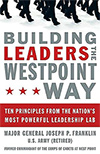Balancing the Science and Art of Leadership
By Ambassador & Lieutenant General (Retired) Dell Dailey , Sunday, January 01, 2017
Leadership is an essential part of any organization’s critical elements for success. Whether your organization is military, law enforcement, media, business (public or private), local government, or a small, but challenged new startup business, leadership matters! There are several different ways to gain that critical leadership skill set. The U.S. Army sends its leaders to formal schooling, at different milestones, until they are mid-level general officers; the schools span from months to a year and are necessary to prepare the officer for increasing levels of responsibility. The U.S. State Department has a different view--in addition to language training, an aspiring Foreign Service Officer will experience a blend of on-the-job training, repeated assignments to similar areas, continuous assignments, and mentoring. How do these two vastly different systems end up working so well? From general officers, who immediately led the Nation in the response to 9-11, to nation building in Iraq and Afghanistan by seasoned ambassadors, how did their leadership skills develop, mature, and became successful? The answer lies in the ability to balance the science and art of leadership.
The generic definition of leadership is the ability to influence an individual to perform a task. It has two basic components. The first is the mechanical or “science” component - it teaches the time-proven steps that provide the fundamentals to those who aspire to lead. They must know and understand the basic skill sets necessary. Values, communication, competency and understanding, appreciation for organizational structure, styles of leadership, techniques to persuade others to follow, and other areas make up the basic “science” leadership skill set. These can be taught by a football coach, parent, math teacher, dance instructor, scoutmaster, former military member, or others.
The second component of leadership is the “art” portion. Some people have this ability inherently, while others must develop it. The “art” part is the passion, empathy, and emotional connection between the leader and follower. This “art” portion can be truly inspirational based on the conditions being experienced, manner in which it is delivered, insight it provides, or the intensity or compassion of the individual.
I suggest the person learning about leadership has five basic aspects they need to master and, at that point, thrust into the responsibilities of being a leader. These five areas are learned as follows:
1. Maintain your values. At West Point, the cadet is inculcated with them as “Duty, Honor, and Country” and “Do not lie, cheat or steal, or tolerate those who do.” I have found a good saying and guide that assists in today’s corporate world is, “In the absence of guidance, what you do must be moral, legal, and ethical.” Integrity, by far, is the one most likely to be violated, routinely challenged, and the value most important to preserve.
2. Be professionally competent. No matter what walk of life one chooses, it is essential you are competent in your field of expertise. Education, training, and offline schooling all will assist, but growing up in the industry is a great way to be professionally competent and, therefore, regarded with considerable respect, as you decide critical issues. Having not grown up in, nor having familiarity with, a specific profession, one can still be competent. Get good advisors and teammates to provide their thoughts. Solicit opinions from others involved. Visit the front-line workers or the industry equivalents in your business, and ask questions. You won’t learn it totally, but the team will see you trying to do so. Respect for you will increase, you will open channels, and it sends the correct message.
3. Maintain continuous communications. This needs to be done both formally (scheduled meetings) and informally (hallway or social sessions) while being done with subordinates, mid-level management, peers outside your company, and your supervisors. While at these sessions, the leader should routinely present a message of some sort, even if it is merely a wrap up. A real leader must also be able to take questions from the most troublesome member, at the most inopportune time, and provide the most informative and sincere response possible. Even if it is, “The team leadership is still looking at this challenging area, and we need a little more time or input before we go public with an informed response.”
4. Have Compassion. Leadership must also have compassion as a key element. Hard or demoralizing decisions—layoffs, reductions in salary, unpopular policy announcements—need to be made and articulated with a true understanding of their impact. Acceptance by the team of these irksome decisions will be far greater understood and acted upon if they know leadership was compassionate and possibly troubled in doing so. They need to know you are also human!
5. Understand your team. Finally, the real leader must understand their team members outside the office or command post. The leader realizes there is much more behind his or her workers than their performance at the work place. There exists the emotional, psychological, and possibly medical stresses that make the worker respond at a high or lower level. Understanding these difficult-to-observe aspects really challenges a leader, but social engagements, non-official events, unexpected time off requests, extended failure to use vacation time, and limited access during non-duty hours for mission critical issues all add up to issues that may affect their team member. The good leader sees these, understands the gravity, and acts to lessen the likelihood of their negative impact. Of course, a very good friend to the leader in this area is the worker’s family. They know the full impact of stress on their loved one and, more than likely, they are looking for assistance.
In closing, I offer two reinforcing points that underpin the leadership lessons. First, a positive comment, rendered to a team member in the conduct of their work, goes a long way. Affirmation is a powerful leadership technique used by the best, but it is even more powerful rendered in a public forum possibly with family present.
Second, there is a saying, “who guards the guardians?” This is a statement capturing the challenge of leaders doing the “right thing”. It’s not an inspector general who ensures this; it’s not rules, regulations and policies; and it’s not training or education… it is their values. Values are what ensure the guardians are properly guarded. A leader’s inherent guidelines must be their values….remember affirmation and values!
Leadership at the highest level is an intricate balance of the science and art. As a start for any leader, values, competence, communications, compassion, and understanding your teammates are critically important areas to learn, understand, and begin to master. These will jump start you to becoming a competent, respected, and compassionate leader.
Ambassador & Lieutenant General Dell Dailey
 ExpertiseExecutive Leadership, Mentoring, Special Operations, Terror/Counterterrorism, National Defense and Aerospace ExperienceAmbassador Dailey’s experiences span 36 years of Army life and an additional two years as the Coordinator for Counterterror in the State Department. As a military dependent and soldier, he has served in Asia, Europe, Middle East, Africa, South America... Read More +
ExpertiseExecutive Leadership, Mentoring, Special Operations, Terror/Counterterrorism, National Defense and Aerospace ExperienceAmbassador Dailey’s experiences span 36 years of Army life and an additional two years as the Coordinator for Counterterror in the State Department. As a military dependent and soldier, he has served in Asia, Europe, Middle East, Africa, South America... Read More +






